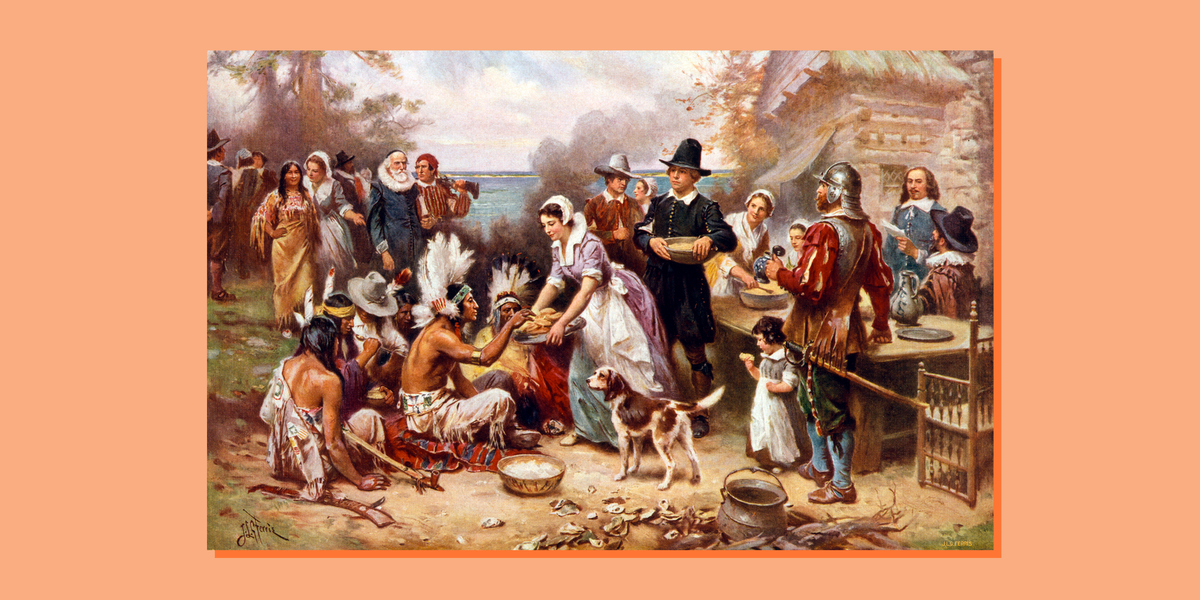As kids, many of us probably learned a sanitized version of the first Thanksgiving story — but it wasn’t all peace, love and pass the gravy. While it’s true that the settlers at Plymouth and their allies from the Wampanoag tribe gathered in 1621 for an epic, three-day feast to celebrate the settlers’ first successful harvest, that’s far from the end of the tale. In kindergarten and beyond, we learn that English religious exiles began establishing civilization in the new world, winning over the local tribes with overtures of friendship, who then taught them how to grow crops to sustain their burgeoning society from that day forward. The real story is a lot more complicated, and a lot less kid-friendly.
Fact is, the peace that brought the Wampanoag and the settlers together at the table wasn’t as solid as we’d like to believe. A lot of bloodshed took place both before and after that first feast. Today, many Native Americans and others mark Thanksgiving as a solemn day of remembrance instead of celebration. Here’s the rest of the details on what went down after the plates were cleared in Plymouth, Mass.
At least 100 people came to dinner
If you’re cooking for a big crowd this year, take comfort in the fact that more than 100 people came to the first Thanksgiving – and they didn’t even have running water! At least 90 Native men and 50 Englishmen came to the feast, Plimoth Plantation colonial foodways culinarian Kathleen Wall told Time. The Native people dined on the ground, as they were accustomed, and the English ate at the table, in the style they were used to.
The assembled likely played games and ran footraces in between dining on deer, geese, turkey and other fowl. The festivities also lasted three days, since it took the Wampanoag a solid two to walk there.
The Wampanoag leader brokered peace
A Wampanoag leader named Massasoit first negotiated a treaty between the Plymouth settlers and the Wampanoag tribe in 1620, including an agreement that no one from either group would harm anyone from the other. They also agreed that, when trading, the settlers wouldn’t bring their guns and the Natives wouldn’t bring their bows and arrows, to further ensure peaceful commerce. For many years, Massasoit and the Pilgrims remained allies, trading English goods for Wampanoag land, natural resources and other assets.
But the tides began to turn after Massasoit passed away in 1661 and his son, Wamsutta took over. Wamsutta himself died mysteriously in 1662 while visiting the Puritans to discuss gathering tensions between the two groups, Atlas Obscura reports. His successor, Metacomet, only fanned the flames.
A treaty violation led to bloodshed
In 1675, three Natives were executed after murdering a man who had served as a translator to the settlers, which only further inflamed tensions. Metacomet feared the Natives would lose claim to more land, and built a coalition of various Native tribes to protect themselves. By the fall of 1675, they began to skirmish with settlers and attacked settlements in Connecticut and Massachusetts.
The Narragansett tribe wanted to remain neutral, but wouldn’t agree to give up Wampanoag who had taken refuge in their encampment, or refuse to harbor women and children from that tribe seeking shelter from the conflict. As a result, the Puritan forces attacked the Narragansett stronghold, killing up to 600 Natives and about 150 settlers in the bloody battle.
The conflict further devastated Native populations
What became known as King Philip’s War ensued, so named after Metacomet’s English moniker. It decimated both the Native tribes and the colonies. Wampanoag abducted settlers and held them ransom, and settlers pillaged and destroyed Native villages. Much of the colonies were burned and looted.
An article in The Historical Journal of Massachusetts says the war’s ultimate death toll could have climbed as high as 30% of the English population and half of the Native Americans in New England. It ended when Metacomet was killed, beheaded and dismembered, according to It Happened in Rhode Island. His remaining allies also got executed or sold into slavery in the West Indies. The colonists impaled “King Phillip’s” head on a spike and displayed it in Plymouth for 25 years, as a macabre effigy to the strife.
Native people never really recovered
That wasn’t the only conflict between Native peoples and the colonists. Other wars raged in Virginia, Connecticut, New York and elsewhere and the Native American population has never really recovered. For many, the settlers’ arrival wasn’t the beginning of a new world, but the end of one.
For that reason, Native Americans and supporters have gathered at noon on Cole’s Hill in Plymouth to commemorate a National Day of Mourning on Thanksgiving Day since 1970. Participants in the National Day of Mourning honor Native ancestors and the struggles of Native peoples to survive today. It’s a day of remembrance, spiritual connection and protest against racism and oppression that Native Americans have experienced and continue to experience, to this day.
So when you gather around your table this Thanksgiving, spare a moment to think about what happened back when the English first arrived and how much Native people still suffer in our country today. We have a long way to go until we’re truly one nation, indivisible, with freedom and justice for all.
This content is created and maintained by a third party, and imported onto this page to help users provide their email addresses. You may be able to find more information about this and similar content at piano.io

